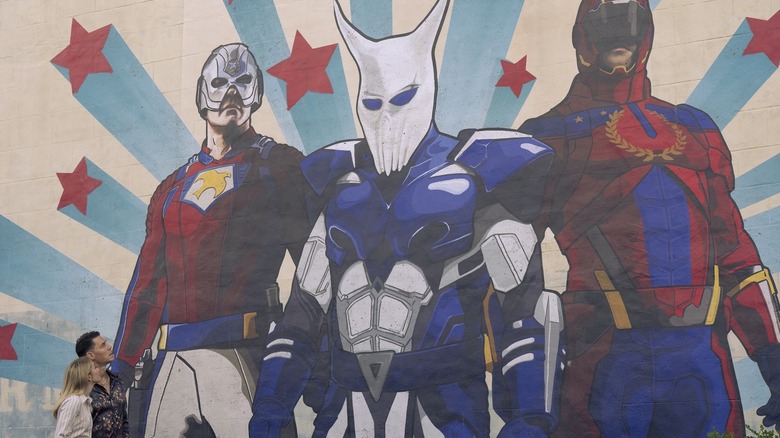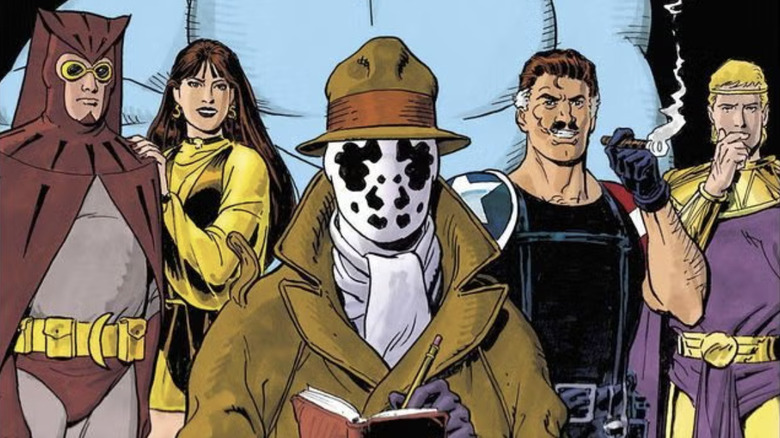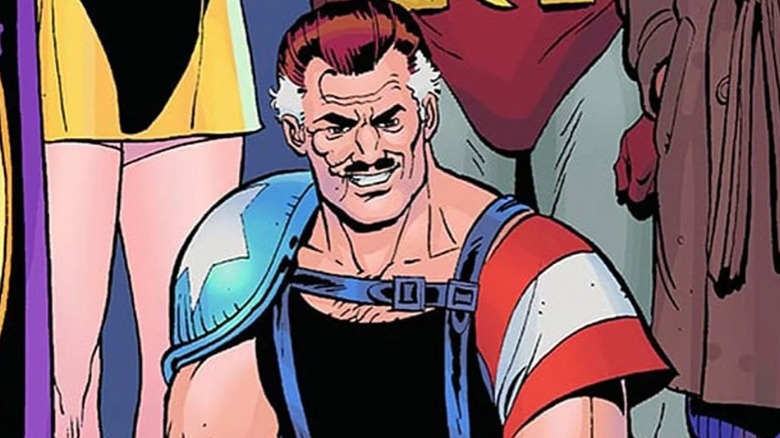Peacemaker Inspired One Of Watchmen's Classic Antiheroes
James Gunn and John Cena have lifted Peacemaker from an obscurity into a star. Before "The Suicide Squad," Peacemaker's biggest contribution to comic history was inspiring a different character. Originally, Alan Moore and Dave Gibbons' beloved "Watchmen" was about investigating the murder of Peacemaker, not the Comedian.
Peacemaker's story does not begin at DC Comics. He was first created in 1966 by writer Joe Gill and artist Pat Boyette, debuting in the issue "Fightin' 5" #40 — which was published by Charlton Comics, not DC. During its forty years of publishing comics, Charlton amassed a decent-sized library of superhero characters, such as Blue Beetle (acquired from the defunct Fox Comics) and the Question (created by Spider-Man co-creator Steve Ditko after he left Marvel). By 1986, though, Charlton had folded and DC had acquired its library. At the same time, Moore and Gibbons were devising the superhero murder-mystery that became "Watchmen."
"The initial idea of 'Watchmen'... was very simple: Wouldn't it be nice if I had [...] a world full of superheroes — preferably from some line that has been discontinued and no longer publishing — whom I could then just treat in a different way," Moore explained to Comic Book Artist magazine. At the time he'd recently written a similar revival of forgotten hero Marvelman (renamed Miracleman) for British comic anthology "Warrior."
Moore first thought for "Watchmen" was to use the Mighty Crusaders from Archie Comics. When he and Gibbons learned DC had the Charlton characters "lying around," they pitched the story with them instead. "The story was about superheroes, and it didn't matter which superheroes it was about," Moore said. As Moore told the Comics Journal, the original title for the "Watchmen" pitch was "Who Killed the Peacemaker?"
Why Watchmen used original characters
DC's executive editor at the time, Dick Giordano, loved the pitch ... except for the stars. Giordano had started his career as a comics artist at Charlton, so he had a "paternal affection" for those characters, per Moore.
"[Giordano] really didn't want to give his babies to the butchers, and make no mistake about it, that's what it would have been," Moore recounted to the Comics Journal. Plus, if "Watchmen" starred the Charlton characters, that would limit what DC could do with them in later stories. Giordano asked Moore and Gibbons to create original characters instead, and in hindsight Moore felt that "Watchmen" worked out better that way. At the time, though, he fretted that original characters might detract from the nostalgia and "resonance" of the book.
"Eventually, I realized that if I wrote the substitute characters well enough, so that [...] certain aspects of them brought back a kind of generic superhero resonance or familiarity to the reader, then it might work," Moore explained to Comic Book Artist.
Moore and Gibbons still used the Charlton characters as the blueprints for the "Watchmen" ones. Rorschach is the Question: a paranoid detective with a fedora and mask. Question's face is a blank skin-colored mask, while Rorschach's is an inkblot; he (like the objectivist Ditko) sees the world in black-and-white. Nite-Owl is Blue Beetle, an animal-themed inventor with a hovercraft. There were two Blue Beetles (Ted Kord had supplanted the original Dan Garrett), and so there were two Nite-Owls: Dan Dreiberg, and the aged original Nite-Owl, Hollis Mason.
Doctor Manhattan is based on the nuclear-powered Captain Atom, and the world's smartest man, Ozymandias, is Peter Cannon aka Thunderbolt (who could use untapped parts of his brain). Silk Spectre replaced Nightshade as the book's female lead, but Moore admittedly drew more on the DC heroine Black Canary.
Finally, the murdered superhero evolved from Christopher Smith/Peacemaker into Edward Blake/the Comedian.
The Comedian in Watchmen is based on Peacemaker
Peacemaker, as created by Gill and Boyette, is a diplomat so devoted to peace he'll take up arms to bring it about. That makes him a character ripe for satire about American patriotism, which Moore and Gibbons used to craft the Comedian character.
"We decided to make him slightly right-wing, patriotic, and we mixed in a little bit of Nick Fury into the Peacemaker make-up, and probably a bit of the standard Captain America patriotic hero-type," Moore recounted to Comic Book Artist. Unmasked, Blake does look like Fury minus the eyepatch, and he's got the same ruthlessness.
The Comedian's name comes from his cruel grin and nihilism; he thinks life is a big joke. "Watchmen" issue #4 shows how Doctor Manhattan won the Vietnam War for the U.S. with his omnipotent powers. One of Gibbons' most chilling drawings is the smirking, red-eyed Comedian wielding a flamethrower there.
The Charlton characters were imported to DC and found new niches — Blue Beetle is famous for starring in the comedic comic book series "Justice League International" – but they are still linked to "Watchmen." In 2014, Grant Morrison and Frank Quitely made "Pax Americana," a "Watchmen" riff that used the Charlton superheroes instead of Moore and Gibbons' analogues. The mystery in this book isn't Peacemaker's murder, but why he of all people assassinated the President of the United States.
DC's 1980s "Peacemaker" comics made him the son of a Nazi, the kind of grimdark twist which "Watchmen" helped popularize. Gunn and Cena's Peacemaker also has this backstory, along with some of the patriotic satire of the Comedian. Peacemaker wears a dove symbol, but his pet is a bald eagle — the symbol of America and a predatory bird of prey. But unlike the Comedian, Peacemaker might shape up into a better man.
"Peacemaker" is streaming on HBO Max.



